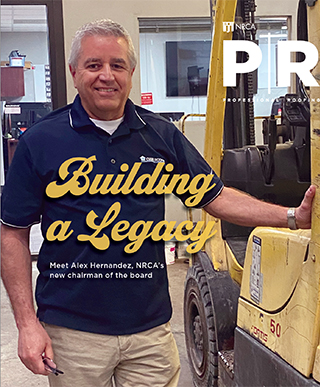Flashing cement works in rain
R.M. Lucas Co. Inc. has developed Lucas #6500 Universal Flashing Cement, a solvent-based synthetic elastomeric resin designed to work in all weather conditions.
The flashing cement reportedly adheres to asphalt, polymer-modified bitumen, TPO, PVC, Hypalon,® metal and EPDM. Polyolefin fibers are said to add reinforcement and body for horizontal and vertical applications that can be used for wet or dry repairs, as well as underwater repairs. The product is available in white or black.
Website: www.rmlucas.com
Telephone: (773) 523-4300
Lock panel includes licensing
New Tech Machinery has made its SSQ275 New Lock Panel Program available to the public. The finished panel can be snap-locked and mechanically seamed, reportedly making it stronger. The panel is available in new and existing SSQ roof panel machines. The panel system includes all licensing and testing for three years, and all updates can be coordinated through New Tech Machinery.
Website: www.newtechmachinery.com
Telephone: (800) 574-1717
Underlayment provides traction
Atlas Roofing has introduced its Weather-Master® TU Ultra SE Peel & Stick SBS Reinforced Underlayment, a self-adhering tile roof underlayment made with a blend of modified asphalt and woven polyester.
Designed to give roofing workers traction during installation of tile, slate or metal roof systems, the polyester surface reportedly bonds with all foam adhesives used in roof tile installations and will hold up under stacked tiles without slipping or damaging the membrane surface. When properly installed, no special adhesives, heat or equipment are necessary to install the peel-and-stick underlayment, which has a 260 F melting point.
Website: www.atlasroofing.com
Telephone: (800) 478-0258
Snow dam prevents avalanches
Thybar Corp. has improved its Snow Dam, an aluminum guard that fastens to a standing seam to allow water from melted snow and ice to safely run off a roof while keeping snow and ice from falling.
The aluminum guard reportedly now can retain up to 2,000 pounds of snow and ice on a roof and has pre-punched holes for fastening to a standing seam. Mastic tape is used between the Snow Dam's base and standing seam to create a watertight seal. Installation can be done at any time during a roof system's life.
Website: www.thybar.com
Telephone: (800) 666-CURB (2872)
Technology detects impending storms
The National Storm Damage Center has created geo-targeted technology that can detect critical characteristics of an impending tornado or hurricane and alert building owners of the crisis via text messages.
The technology uses multiple weather radar systems to collect information that is analyzed by meteorologists. Users can download an app that will send text messages about an impending storm, including its location, ferocity and duration. The app also features a portal for building owners to be paired with contractors and public insurance adjusters.
Website: www.stormdamagecenter.org
Telephone: (888) 598-6980
PV modules receive upgrade
CertainTeed Corp.'s Apollo® II Solar Roofing System now features 60-watt monocrystalline integrated photovoltaic (PV) panels. The lightweight, durable panels reportedly resist wind uplift and easily integrate into an existing roof system or during the installation of a new roof system that combines PV panels with asphalt shingles or flat concrete tiles.
Each 12-pound module contains 14 high-efficiency monocrystalline silicon solar cells, and its low-profile design reportedly does not require structural reinforcement. It also features an open area under the modules to allow for easier electrical wiring.
The same features also can be found on the Apollo Tile II system designed for flat, concrete tiles.
Website: www.certainteed.com
Telephone: (800) 782-8777
NRLRC releases new publication
The National Roofing Legal Resource Center (NRLRC) has published NRLRC Contract Provisions Volume V. Written by attorneys and compiled by NRLRC, the publication provides formal, legal contract provisions roofing contractors can insert directly into their contracts and includes plain-language explanations of the contract provisions.
The book also addresses issues such as payments to subcontractors and suppliers; the cancellation clause of a residential contract; fines and penalties responsibility; and a roofing contractor's warranty or guarantee obligations.
For more information, visit shop.nrca.net or contact NRCA's Customer Service Department at (866) ASK-NRCA (275-6722) or info@nrca.net.



